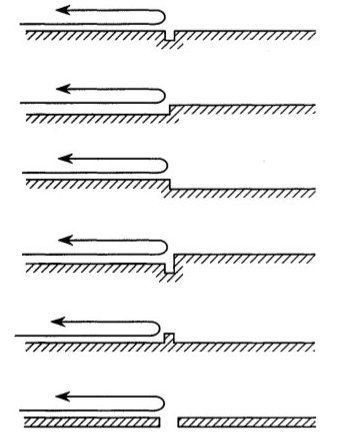A question was asked that since we know that an aircraft's radar cross section (RCS) value can change with aspect angles, with the top/bottom views the greatest, next are the laterals, and front/rear the least, why is the front RCS value always the one presented to the public?
An often given answer is that it is to give as favorable a presentation about the aircraft as possible while remaining technically truthful without sounding too much like sales pitch. On the surface, it sound plausible enough, but given the nature of radar detection, the truth is more complex.
First...We should have a brief review on how radar detection works...
The above illustration is how a flat plate, regardless of dimensions, will offer the receiver side the greatest amount of reflection, or radar observability. That direct reflection is called 'specular reflection' or 'specular energy'. Basic geometry tells us that the angle of deflection is equal to the angle of incident. So as the flat plate is tilted or 'cant' away from perpendicular, the greater the cant angle, the less the amount of reflected energy will be returned to the receiver. The less that amount, the less we have of target resolutions. If the flat plate is so tilted that it is almost horizontal, as how the radar would see it, then we will have statistically insignificant energy. Instead of specular energy, we will have surface wave effects and that is for another discussion.
Because of this behavior...
Receiver B will receive the most amount of specular energy. Lower for Receiver A. And if we have a receiver at the Transmitter location, that receiver will have the lowest amount of specular energy.
Because the aircraft is in constant motion through 3D space, the only time a radar receiver will be looking
CONSTANTLY at the aircraft is if it is looking at the nose or tail. Either approaching or receding.
Put this another way, if a radar station is looking at the aircraft's top/bottom or laterals, the aircraft is moving
ACROSS the radar's field-of-view and the laws of geometry (reflection) applies. At several hundreds km/h it will not be long before the radar station loses contact. Worse yet for the radar station if the aircraft is purposely designed to have some influences on those reflections via body shaping.
This is the true reason why front/rear aspect RCS values are often presented: That tactically speaking, because of the briefness of such views, top/bottom and lateral RCS values, while very important, they are of lesser tactical significance than front/rear aspects because the radar will be looking
CONSTANTLY at those front/rear aspects. Canting the vertical stabs to eliminate corner reflectors reduce further the brevity of lateral aspect viewing.
Now we touch briefly on surface wave behaviors because now the radar impinging signals are either at horizontal or near horizontal to the aircraft's surface...
As the wave travels on the surface, any surface discontinuities such as panel gaps either through manufacturing defects or uncaring maintenance, screw heads, or gouges will send a portion of the wave energy back to the receiver. If enough of these surface discontinuities exists, the radar will have valid target resolutions, even when the front view is usually the least in terms of area presentation.
This is why designers work hard at reducing front/rear aspect RCS, particularly the front because the aircraft will be entering hostile territory.















